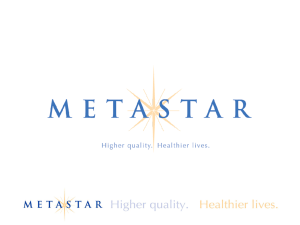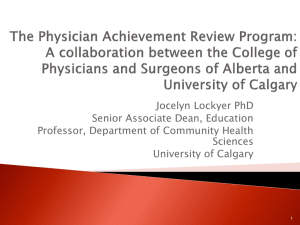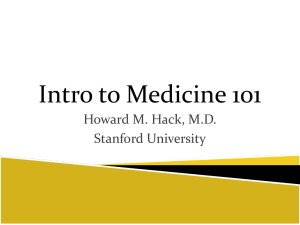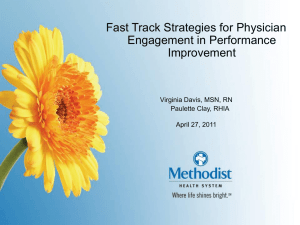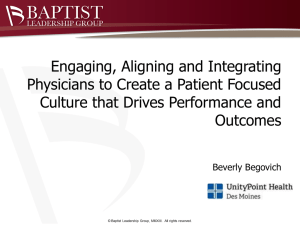Chapter 13
advertisement
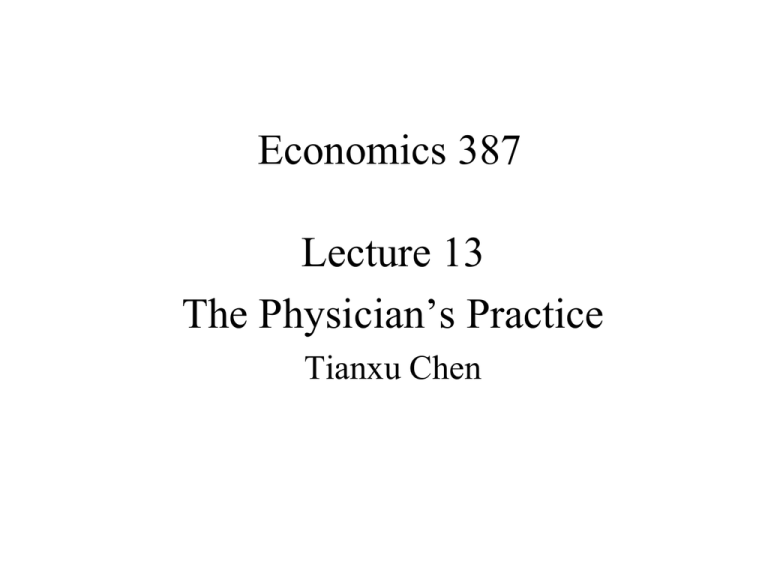
Economics 387 Lecture 13 The Physician’s Practice Tianxu Chen Outline • A Benchmark Model of the Physician’s Practice • Physician Agency and Supplier-Induced Demand • Modeling Supplier-Induced Demand • Diffusion of Information and Small Area Variations • Other Physician Issues and Policy Puzzles • Conclusions A BENCHMARK MODEL OF THE PHYSICIAN’S PRACTICE Utility Maximizing Physicians • McGuire and Pauly (1991) describe physicians as utility maximizers which means that physicians value items besides profit. • In this benchmark model, the physician gets utility from (1) net income and (2) leisure, and disutility from (3) inducement, the physician’s own efforts to induce patients to buy more care than appears medically necessary. Utility Maximizing Model • Let the physician’s utility function be: U = U (p, L, I ) • where p is the net income from the practice; L is the physician’s leisure time, and I is the degree of inducement. The physician can choose any amount of labor and inducement effort consistent with the profit level that is implied by these choices. Figure 15-1 Supply of Physician Labor Some Results from this Model • “Backward-bending labor supply curve” • A rise or fall in income, for any reason, will cause the physician to reevaluate the choice about how much to work. • Physicians can induce demand for their services but they dislike doing so. Figure 15-2 Physician’s Response to Reduced Rate Profit Do Physicians Respond to Financial Incentives? • Nassiri and Rochaix, 2006 found that when physicians are paid per service provided, they provide more services than when they are given a fixed total payment, known as capitation. • Studies also suggest that physicians respond to income pressures on their practice by striving to increase their incomes (Iversen, 2004; Gruber and Owings, 1996; Plotzke and Courtemanche, 2011; Quast, Sappington, and Shenkman, 2008; Rizzo and Zeckhauser, 2003, 2007). PHYSICIAN AGENCY AND SUPPLIER-INDUCED DEMAND • On becoming ill, consumers hire health care professionals to serve as agents. In medicine, we identify the physician as the agent, and the patient as the principal. • The policy concern is that out of self-interest physicians may violate their roles as agents. Modeling Supplier-Induced Demand • Health economists have modeled supplierinduced demand for at least two reasons. - First, one wishes to understand the motivations of physicians, how their incentives affect their practice. - Second, models are needed to understand the data we observe. Figure 15-3 The Supply and Demand Model of SID • We do not need supplier-induced demand to predict increases in quantity of services arising from increase in supply, the simple supply and demand model predicts this result. The Target Income Hypothesis • This argues that physicians have desired incomes that they strive to achieve or to restore whenever actual income falls below the targets. This target income model is a special case of the benchmark model, though a relatively extreme one. • This extreme focus on an income target, as well as the disinterest in further income in excess of the target, constitute features that have caused many health economists to question the target income idea. The Benchmark Model as a Synthesis • The McGuire-Pauly synthesis tells us that the size of the income effect is critical to understanding and identifying SID behavior. A lower profit rate, m, has two offsetting effects on inducement: - Substitution effect: If inducement is less profitable (smaller m), providers would do less inducement, that is, substitute away from it. - Income effect: Decreased income would make inducement more desirable. Figure 15-4 The McGuire-Pauly Synthesis of SID Benchmark Models The Parallel Between Inducement and Marketing • The “four P’s” of marketing are: Product, Place, Price, Promotion. Any firm facing a setback in net revenues might choose to improve the product quality, provide its service at a new location, or use one of several ways to improve its promotion. • A firm can also provide misinformation, and it could engage in narrowly self-interested behavior, or even in fraud. The research problem is that it is difficult to distinguish socially harmful SID from the more benign forms of the inducement practices. What Do the Data Say About Supplier-Induced Demand? • Two criticisms were raised about much of the earlier SID work. - First, many of those studies could not distinguish between the SID model and the conventional supply and demand model. - Second, many estimates of the SID effect proved to be statistically flawed, meaning that the econometric coefficient that was thought to be evidence of SID could not be disentangled from other coefficients. Physician Fees, Fee Tests, and Fee Controls • McGuire (2000) showed that the implications of availability on fees in when physicians operate in monopolistically competitive markets are not so clear. • Feldman and Sloan, 1988 show that if physicians can adjust their quality in response to increased competition, then higher fees could result even when there is no inducement. Physician Fees, Fee Tests, and Fee Controls • Rizzo and Blumenthal (1996) use surveys of physicians to compare their desired incomes to their actual current incomes. Physicians with greater “gaps” were found to demand greater price increases. • Rizzo and Zeckhauser (2003) find the physicians whose current incomes fall below their reference incomes are observed to show greater income growth than the average of other physicians in subsequent periods. DIFFUSION OF INFORMATION AND SMALL AREA VARIATIONS • Are the substantial variations in medical and surgical use rates per capita across small geographic areas caused by information problems? Table 15-1 Variations by Medical Procedure Category Contributions to These Variations • Much of the SAV work focuses on the contribution of socioeconomic characteristics of the population and the role of the availability of supplies of hospital and physician services (see Alexander et al., 1999). The studies together reached two conclusions: Supply variables are important and demand characteristics play a somewhat lesser role though both are statistically and materially significant. Such variables do not seem to suffice, as much variation is left unexplained (Folland and Stano, 1990). The Physician Practice Style Hypothesis • Wennberg (1984) argued that much of the observed variation is closely related to the degree of physician uncertainty with respect to diagnosis and treatment. • Practice style probably varies among physicians due to an incomplete diffusion of information on medical technologies. Formulation of Practice Style • We assume throughout that physicians have a practice style and that it is created and altered by the irregular diffusion of information. • Epstein and Nicholson (2009) find that a physician’s residency has relatively little influence on his practice style. Stronger influences are his peers with the hospital where he practices as well as his peers in the other hospitals in his region. Education, Feedback, and Surveillance • Studies show that information programs directed at physicians can alter their behaviors and thus presumably their practice styles. One study found that an informational program significantly affected the tonsillectomy rates in 13 New England areas. Comparing Utilization Rates in Homogeneous Areas • Wennberg and Fowler (1977) found that morbidity and many socioeconomic variables were not sufficient in explaining the variations in a region and concluded that variations in use rates probably are due largely to practice style differences across the small areas. Multiple Regression Approaches • Phelps and Parente (1990) found that standard demand and supply variables typically account for between 40 and 75 percent of the variation in their study of 134 separate diagnostic categories. • Escarce (1993) found that 43 percent of the variation in cataract surgery rates for the Medicare population is explained by socioeconomic variables. SAV and the Social Cost of Inappropriate Utilization • The most important issue in the SAV literature is the proposition that substantial variation in utilization rates is an indication of inappropriate care. • Phelps and Parente find that the welfare loss due to variations from “true” practice in the nation total $33 billion. OTHER PHYSICIAN ISSUES AND POLICY PUZZLES Malpractice • Many malpractice judgments are very large and malpractice insurance premiums can be very high for the most suit-prone specialties. • Polsky and colleagues (2010) found that higher malpractice premiums tended to increase the rate of exit and reduce the rate of entry of obstetricians. Premium increases averaging 20 percent per year led to a decline in the obstetrician supply of 5.3 percent. • Helland and Showalter (2009) found that a one percent increase in liability leads to a -0.285 percent decline in work hours for physicians. Direct-to-Consumer Drug Advertising • Direct-to-consumer drug advertising became legal in 1985, and to date (2011) occurs only in the United States and New Zealand. • Bradford and colleagues (2010) studied physician data from 27 states, reaching the encouraging conclusion that direct advertising reduced the time from when patients perceived the symptoms to when they are treated by the physician: a benefit to patient welfare. • Hai Fang et al. (2008) found that those patients “educated” by advertising and the Internet, often take an excessive amount of physician time, creating an external cost to other patients. Paying for Outcomes • When a customer gets a car repaired, the mechanic usually guarantees the work, and if the outcome is not satisfactory the customer can go back and have the mechanic make things right. Why can’t we do the same with physicians? • Dranove and White (1987) have argued that the common physician form of contract stems from both the difficulty of evaluating the health status of the returning patient as well as the fact that unobservable patient behavior is very important to the outcome. CONCLUSIONS • Our benchmark model depicts the physician as someone who values positively net income, and leisure, and dislikes inducing patient demand. • The model shows that for the supplier induced demand (SID) hypothesis to be supported, the physician’s income effect must be positive and substantial. CONCLUSIONS • Small area variations can be understood as a result of uneven diffusion of medical information to these same physicians. • Malpractice litigation has effects on entry and exit patterns of physicians. Direct-to-consumer advertising of drugs can be beneficial in some cases.

